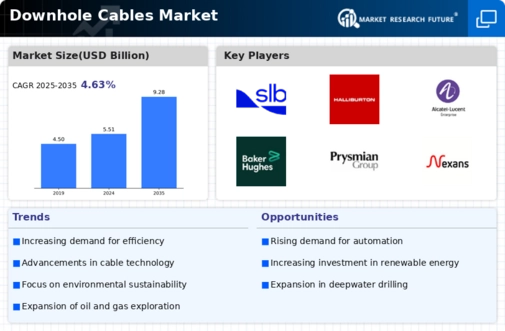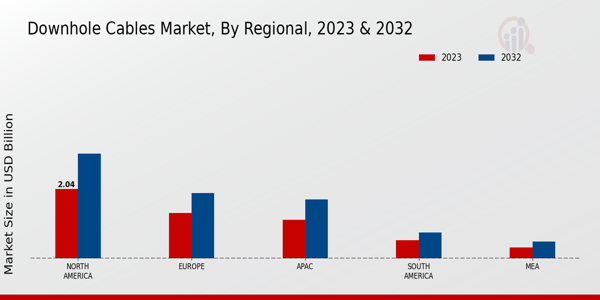Technological Advancements
Technological innovations play a crucial role in shaping the Global Downhole Cables Market Industry. The introduction of advanced materials and manufacturing techniques enhances the performance and durability of downhole cables. For instance, the development of fiber optic cables allows for real-time data transmission, which is vital for monitoring well conditions. These advancements not only improve operational efficiency but also reduce downtime, thereby increasing productivity. As companies seek to optimize their operations, the demand for high-performance downhole cables is likely to rise, contributing to a compound annual growth rate of 4.85% from 2025 to 2035.
Growing Renewable Energy Sector
The Global Downhole Cables Market Industry is also influenced by the burgeoning renewable energy sector. As the world shifts towards sustainable energy sources, the need for efficient downhole cables in geothermal energy production is becoming increasingly apparent. These cables are essential for transmitting power from geothermal wells to the grid, thus facilitating the transition to cleaner energy. The integration of downhole cables in renewable projects not only supports environmental goals but also opens new avenues for market growth. This trend is expected to bolster the market, contributing to its expansion alongside traditional oil and gas applications.
Regulatory Support and Standards
Regulatory frameworks and industry standards significantly impact the Global Downhole Cables Market Industry. Governments worldwide are implementing stringent regulations to ensure safety and environmental protection in oil and gas operations. Compliance with these regulations necessitates the use of high-quality downhole cables that meet specific performance criteria. As a result, manufacturers are compelled to innovate and enhance their product offerings to align with regulatory demands. This dynamic creates a favorable environment for market growth, as companies invest in advanced technologies to meet compliance standards, thereby driving the demand for downhole cables.
Increasing Demand for Oil and Gas
The Global Downhole Cables Market Industry experiences a notable surge in demand driven by the expanding oil and gas sector. As exploration and production activities intensify, the need for reliable downhole cables becomes paramount. In 2024, the market is projected to reach 5.51 USD Billion, reflecting the industry's reliance on advanced technologies for efficient operations. The cables facilitate communication and power supply in extreme conditions, ensuring operational efficiency. This trend is expected to continue, with the market anticipated to grow to 9.28 USD Billion by 2035, indicating a robust growth trajectory fueled by the ongoing investments in oil and gas exploration.
Expansion of Oil and Gas Exploration Activities
The expansion of oil and gas exploration activities in untapped regions is a key driver of the Global Downhole Cables Market Industry. As companies venture into deeper and more challenging environments, the need for specialized downhole cables becomes critical. These cables are designed to withstand extreme pressures and temperatures, ensuring reliable performance in harsh conditions. The ongoing exploration efforts are expected to propel the market forward, with projections indicating a growth from 5.51 USD Billion in 2024 to 9.28 USD Billion by 2035. This expansion reflects the industry's commitment to harnessing new resources and optimizing production capabilities.






















Leave a Comment